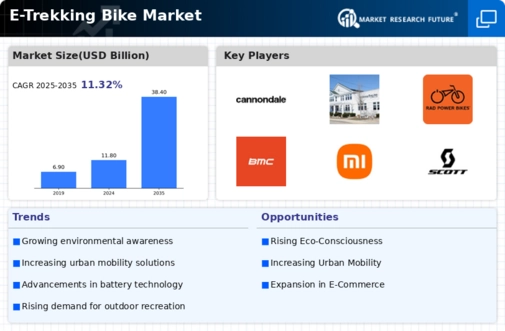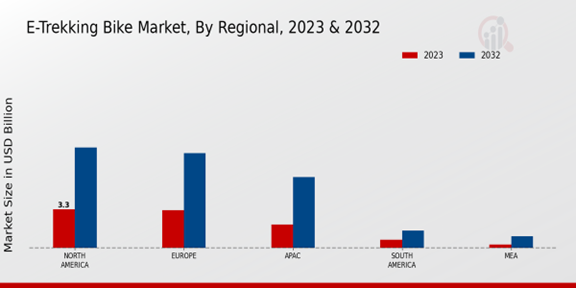Market Growth Projections
The Global E-Trekking Bike Market Industry is projected to experience substantial growth over the coming years. With an estimated market value of 11.8 USD Billion in 2024, the industry is expected to expand significantly, reaching 38.4 USD Billion by 2035. This growth trajectory indicates a robust compound annual growth rate (CAGR) of 11.32% from 2025 to 2035. Such projections reflect the increasing consumer interest in e-trekking bikes, driven by factors such as sustainability, health consciousness, and technological advancements. The market's potential for expansion suggests a promising future for stakeholders involved in the e-trekking bike sector.
Expansion of Cycling Infrastructure
The Global E-Trekking Bike Market Industry is positively influenced by the expansion of cycling infrastructure in urban areas. Governments worldwide are investing in bike lanes, parking facilities, and other amenities to promote cycling as a sustainable mode of transport. This investment not only enhances safety for cyclists but also encourages more individuals to consider e-trekking bikes as a practical commuting option. As cities become more bike-friendly, the market is likely to experience increased adoption rates. The combination of improved infrastructure and growing consumer interest may create a favorable environment for sustained market growth.
Rising Popularity of Adventure Tourism
The Global E-Trekking Bike Market Industry is experiencing growth due to the rising popularity of adventure tourism. As more travelers seek unique and immersive experiences, e-trekking bikes provide an excellent means to explore diverse terrains and landscapes. This trend is particularly evident in regions known for their natural beauty, where guided e-bike tours are becoming increasingly popular. The ability to cover greater distances with less physical exertion appeals to a wide range of tourists, potentially driving demand for e-trekking bikes. This growing interest in adventure tourism may contribute to the overall expansion of the market.
Technological Advancements in E-Bike Design
Technological innovations play a crucial role in shaping the Global E-Trekking Bike Market Industry. Advances in battery technology, motor efficiency, and lightweight materials enhance the performance and appeal of e-trekking bikes. For instance, the introduction of lithium-ion batteries has significantly improved range and charging times, making these bikes more user-friendly. As manufacturers continue to innovate, the market is likely to attract a broader audience, including recreational cyclists and commuters. This technological evolution could contribute to the market's growth, with projections indicating a rise to 38.4 USD Billion by 2035.
Growing Demand for Eco-Friendly Transportation
The Global E-Trekking Bike Market Industry is witnessing a surge in demand for eco-friendly transportation solutions. As urban populations expand, consumers increasingly seek sustainable alternatives to traditional vehicles. E-trekking bikes, which combine electric assistance with cycling, offer a practical solution for reducing carbon footprints. In 2024, the market is projected to reach 11.8 USD Billion, reflecting a growing awareness of environmental issues. This trend is further supported by government initiatives promoting green transportation, which may encourage more individuals to adopt e-trekking bikes as a viable commuting option.
Increasing Health Consciousness Among Consumers
The Global E-Trekking Bike Market Industry benefits from a rising trend in health consciousness among consumers. As individuals become more aware of the importance of physical activity, e-trekking bikes offer an appealing solution that promotes fitness while providing the convenience of electric assistance. This dual benefit attracts a diverse demographic, from fitness enthusiasts to casual riders. The ability to engage in outdoor activities while enjoying the advantages of electric support may lead to increased sales and market penetration. The anticipated growth rate of 11.32% CAGR from 2025 to 2035 suggests that this health trend will significantly impact the market.











